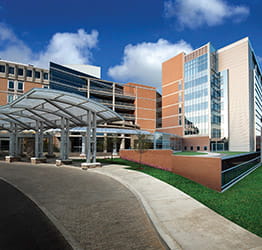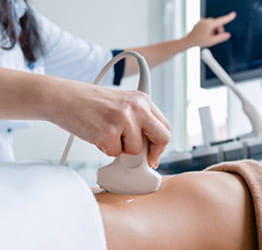On this page
What Is Facial Augmentation?
Cosmetic facial augmentation, or facial implant surgery, involves placing artificial implants to enhance or alter specific structural features of the face. Facial augmentation is a type of plastic surgery.
Reasons you may want or need to have facial augmentation include:
- As part of gender-affirming surgery for individuals age 19 and older.
- As part of reconstructive surgery after an injury or accident.
- For cosmetic reasons.
Facial implants are made from solid biocompatible materials. They change the underlying structure of your face and can create better facial proportions and balance. Facial augmentation surgery often is combined with other facial contouring procedures.
These additional procedures may include:
What are the different types of facial augmentation?
Here are the most common types of facial augmentation:
Chin implants
Available in various styles, chin implants offer options for horizontal, vertical, and square dimensions that extend along the jawline. Depending on your size and preference, a chin implant can be inserted through an incision under the chin or inside the lower lip. The implant is then secured to the bone using sutures or small screws. If performed independently, the procedure typically takes approximately 30 to 45 minutes.
Cheek implants
In various styles, cheek implants are designed to enhance the malar (cheekbone) and submalar (just below the cheekbone) areas. These different implant styles allow for a range of effects. Surgeons typically place cheek implants through small incisions high under the upper lip. Sometimes, they may use eyelid incisions if simultaneous eyelid surgery is performed.
Depending on the implant style and the desired outcome, cheek implants can be positioned on the front of the cheekbones or further back along the tails. When performed independently, the procedure usually takes approximately 60 minutes.
Nasal implants
Nasal implants serve multiple purposes, including elevating the bridge or dorsal line and enhancing tip projection. While they can be performed independently, they are more commonly part of comprehensive nose reshaping surgery.
Paranasal implants are used to augment the base of the nose. These implants wrap around the pyriform aperture (the heart- or pear-shaped opening in the human skull) to provide midface projection by pushing the base of the nose outward. Surgeons typically place these implants via an incision inside the mouth, just below the upper lip. Alternatively, they can be placed using an incision inside the nose during rhinoplasty (nose job).
Orbital rim or tear trough implants
These implants can be used to address infraorbital rim weakness or undereye hollows. These implants are positioned along the infraorbital rim through various lower eyelid incisions, enhancing projection and adding fullness to the undereye area. Tear trough implants are commonly used in conjunction with other lower eyelid rejuvenation procedures.
Temporal implants
These implants effectively address temporal hollowing when inserted through a small incision in the hairline near the temples. Positioned on top of the temporal muscle, just beneath its enveloping tissue, these implants come in two primary styles: standard, which fills in the hollowing to the side of the eye, and extended, which extends from the side of the eye up to the side of the forehead.
Surgeons often perform this procedure as a standalone intervention, typically taking about one hour to complete.
Lip implants
These soft, spongy, cylindrical structures replicate the natural feel of lip tissue. Available in various lengths and thicknesses, they cater to diverse facial aesthetics. Surgeons typically insert them through small incisions at the corners of the mouth, using local anesthesia, often in an office-based setting.
Custom-designed facial implants
Advances in facial implant technology have led to a wider range of options beyond standard off-the-shelf implants to address unique needs, including facial asymmetry and specific aesthetic goals. With 3-D CT scanning, surgeons can create personalized implants that mimic natural contours. These custom implants are both accessible and cost-effective, revolutionizing facial augmentation
While you can get implants in any part of your face, the most common types of facial implants are:
- Cheek implants.
- Chin implants.
- Mandible (jaw) implants.
Implants are solid, biocompatible materials like silicone rubber. They come in many sizes and shapes. Custom-made implants are an option, but they take longer to make and are more expensive.
Back to top
What Are the Benefits of Facial Augmentation?
If the sides of your face don't match, facial implants can help correct problems with facial symmetry. They also can help fill in facial deficiencies, such as a sunken chin or weak jawline.
Cosmetic facial implants can:
- Create definition and fullness in your cheeks.
- Increase your chin projection — how far your chin comes forward — improving your profile.
- Plump your tear trough (lower eyelid) area, making you look less tired.
- Restore your facial contour and proportion, reversing signs of aging and helping you look younger.
- Strengthen your jawline so it no longer blends in with your neck.
Back to top
What are Facial Augmentation Risk factors and Complications?
Facial augmentation risk factors
Facial augmentation surgery is an invasive surgical procedure. That means surgeons will cut the skin open.
In addition to the risks associated with anesthesia, you have a risk of:
- Infection.
- Minor nerve damage.
- Shifting or movement of the implant.
Facial augmentation is not a good option for every person. Your plastic surgeon will review your potential risks and complications before surgery.
How long is the recovery for facial augmentation?
The recovery process after facial augmentation is closely tied to the extent and duration of swelling. About 50% of the swelling typically subsides within 10 days after surgery. Approximately 75% of the swelling goes down by three weeks, and up to 95% should resolve by six weeks post-procedure.
Generally, there are no physical restrictions after surgery. However, it’s essential to note that the full results of facial implant plastic surgery become visible only two to three months after the procedure, once most of the swelling has gone down.
Although infection and permanent sensory loss are the most significant medical risks associated with cosmetic surgery, these risks are rare. More commonly, aesthetic concerns arise, such as implant movement, over- or under-correction, and dissatisfaction with cosmetic outcomes.
Addressing these aesthetic issues often requires additional revision surgery.
How common is facial augmentation?
Chin, cheek, and jaw augmentation surgeries are not uncommon, but they are not among the top-10 facial plastic surgery procedures performed by volume in the U.S.
According to a report by the American College of Plastic Surgeons, in 2023, malar augmentation (cheek implantation) was most commonly performed on people ages 40 to 54 (34% of all cheek implants nationwide), followed by those ages 20 to 29 (22%), 30 to 39 (19%), and 70+ (16%).
Mentoplasty (chin augmentation) was most commonly performed on people ages 20 to 29 (29% of all chin implants nationwide), followed by those ages 30 to 39 (24%), and those ages 40-54 and 70+ (both 16%).
Female patients make up roughly 98% of the patient base for both procedures.
Back to top
Is Facial Augmentation Right for Me?
The best way to determine if you're eligible for facial augmentation is to schedule an appointment with an experienced cosmetic plastic surgeon. Generally, suitable facial augmentation candidates have less prominent facial bone structures in the orbital, malar, midfacial, or mandibular regions. Temporary dermal fillers can be used as a trial method to see if a long-lasting implant solution is suitable for you.
For many people, facial augmentation can improve their self-image and self-confidence.
You may qualify as a good candidate if:
- You are in good physical and mental health.
- You don't smoke.
- You have specific and realistic goals on how you want your face to look.
Back to top
How to Prepare for Facial Augmentation
Facial augmentation surgery usually is an outpatient procedure. When you've scheduled your procedure, you will receive details on how to get ready. It will include information on any lab testing needed before the procedure. You’ll also be given instructions on when to arrive, when to stop eating/drinking, what medicines to avoid, and more.
A friend or family member must take you to and from the procedure. If you don't have someone picking you up, they won't do the surgery. You cannot drive yourself home.
Back to top
What to Expect During Facial Augmentation Surgery
Before the procedure
To help with implant placement, your surgeon will first draw surgical markings on your face. These markings help them know where to make the incision and what areas to avoid. The care team will monitor your heart and blood pressure.
Surgeons do facial implants under local anesthesia (numbing) or under general anesthesia (medication that will make you sleep). Your doctor will suggest the best type of anesthesia for you. Before the procedure, an anesthesiologist will give you the medications.
During the procedure
During the procedure, you will lie face-up on the operating table. Because of the anesthesia, you will not feel pain. If you are under general anesthesia, you also won't be awake.
The surgeon will make a small incision near where they will place the implant, creating a pocket in your facial tissue. In some cases, your surgeon may make cuts inside your mouth.
Then, they will gently insert the implant into the pocket. The muscles and tissues surrounding the pocket hold the implant in place.
After placing the implant, your surgeon will use fine sutures or stitches to close the opening. They will also bandage or tape it so it can heal.
Depending on what else you have done, they may use a compression bandage to apply pressure. The compression bandage helps reduce swelling, bleeding, and bruising.
How long your implant surgery takes will depend on what types of implants you receive. Facial implants take 30 minutes to two hours to put in. Your surgery time will take longer if you have other facial plastic surgery procedures done at the same time.
Recovering after facial augmentation surgery
After surgery, you will be moved to a recovery room for a few hours. The care team will monitor your blood pressure and heart rate to make sure you're ok to go home. Most people can get up and walk around after surgery. Avoid any other activities for the day.
Before you go home, your care team will review how to care for your incisions and promote healing. To heal quickly after surgery, avoid smoking. When you smoke, it takes longer for wounds to heal. Smoking also can increase the risk of infection.
You will receive written care instructions. Your surgeon may ask you to use cold compresses to reduce bruising and swelling. How quickly you heal will depend on the type of implants you get and other procedures you have.
You’ll be asked to schedule a follow-up visit so the surgeon can follow up on your healing.
Right after facial augmentation, you may have:
- Bruising.
- Numbness.
- Pain.
- Swelling.
During the first two weeks after facial augmentation, you may be unable to move your face normally.
Here's what else you can expect:
- You may need to follow a liquid or soft food diet for up to 10 days, depending on where your sutures are and how you are healing.
- Most people can return to work and normal life after one week.
- Your sutures will stay in for five to 10 days. Your surgeon will remove them during a follow-up visit. If your surgeon makes cuts inside your mouth, those sutures dissolve on their own in about five to 10 days.
- It will take several weeks for your incisions to heal fully.
- You should sleep in an inclined position, at a 45-degree angle, for at least a week after surgery.
- You may continue to have swelling for a few months after surgery.
- You can return to strenuous physical activity four to six weeks after surgery or when your surgeon approves.
Facial implants are permanent. Most people have lifelong results.
Though rare, you may have problems after facial implant surgery. The implants may fracture or shift with normal activity or facial trauma. They may become infected.
Back to top
Costs of Facial Augmentation
Most health insurance plans will not cover facial augmentation surgery for cosmetic reasons. The average costs for facial augmentation surgery, according to the American Society of Plastic Surgeons, are:
- For cheek augmentation — $3,876.
- For chin augmentation — $3,641.
The cost of surgery typically includes:
- Anesthesia fees.
- Hospital or surgical facility costs.
- Medical tests.
- Prescriptions for pain medicine.
- Surgeon's fee.
Back to top
Why Choose UPMC for Facial Augmentation?
Good plastic surgery should look like it's a natural fit for you. That requires choosing an experienced plastic surgeon for your facial augmentation.
UPMC's facial plastic surgeons are board-certified. These certifications include the American Board of Facial Plastic and Reconstructive Surgery and the American Board of Otolaryngology.
Schedule a free consultation
Facial plastic surgery is a highly personal decision. To help you decide if facial implants are right for you, schedule a free visit with one of UPMC's facial plastic surgeons.
















